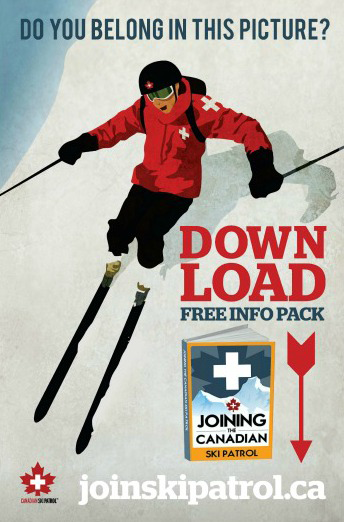Canadian Ski Patrol (CSP)
The Canadian Ski Patrol is a national, non-profit, registered charitable organization that is volunteer-based and provides advanced first aid and emergency response services at more than 230 ski resorts and Nordic centers as well as hundreds of recreational and sporting events across Canada. The CSP has more than 4,500 members consisting of all alpine disciplines, Nordic skiers as well as non-skiers, making it the largest volunteer-based certified first responder organization in Canada.
History
In 1941, a doctor of osteopathic medicine named Douglas Firth was asked by the Canadian Amateur Ski Association (CASA) to organize and train a first aid rescue group to patrol the ski hills in the Toronto area. It was from this request that the Canadian Ski Patrol System (CSPS) was formed. The CSPS was originally a standing committee of the CASA with independent patrols in different areas. During the years between 1941 and 1948, the Second World War restricted expansion, but the Toronto-area and Montreal-area patrols united to form the nucleus of a national organization.
In the 1960s, following a dramatic increase in the popularity of skiing as a family sport, the services that the CSPS provided were in great demand. Registration grew to more than 650 individuals, with members providing services in Quebec, the Lakehead area (now Thunder Bay, Ontario), Winnipeg, Calgary and Edmonton in addition to the original central Ontario and Montreal regions.
In 1961, the CSPS became an accredited national charity and gained independence from the CASA.
In 1967, Governor General Georges Vanier became the first patron of the CSPS.
During the late 1960s, expansion continued both east and west with the addition of an Atlantic Division and formation of a zone which covered a broad area in the interior of British Columbia. Membership grew proportionately, with approximately 2,500 patrollers registered by the end of the decade. The following year, Saskatchewan Division was formed and, by 1975, registration had reached 4,200 patrollers.
A national management committee was established in 1978 to handle the operation of the system and the following year the organization moved its head office to a permanent facility in the Ottawa area. The head office remains in the same location today there, with three full-time staff members who manage day-to-day operations.
In 2013, the Canadian Ski Patrol System name was officially changed to the Canadian Ski Patrol (CSP) and the current logo, of a red leaf with a white cross was adopted.
Organizational Structure
The Canadian Ski Patrol is governed by a national board of directors, consisting of a chair, the national president/chief executive officer and six other members, with the member directors and the chair serving two-year elected terms. The organization is managed by a national management committee of five vice-presidents who report directly to the national president/CEO. Their portfolios include administration, education, communications, operations and fund development. Nationally, the organization is divided into nine divisions, 59 zones and roughly 220 patrols, all of which are led and managed by their own elected executive teams.
The CSP is divided into the below 9 divisions:
- Atlantic East Division
- Atlantic West Division
- Quebec Division
- Ontario Division
- Manitoba Division
- Saskatchewan Division
- Mountain Division
- Pacific North Division
- Pacific South Division
Training
Advanced First Aid
Recognized by the federal government, all patrollers are required to complete or recertify annually in an advanced first aid course, which includes CPR, AED, Oxygen Therapy, and WHMIS training. They also receive on-snow and accident-scene management training as well as safety education. Following successful completion or re-certification of their training, each member is certified in advanced first aid and rescue procedures as an advanced first aid responder.
The initial certification course is a minimum of 60 hours, while annual re-certification courses are a minimum of 16 hours. Successful completion of a certification course also requires successful completion of written, skills, diagnostic and CPR/AED testing.
The first aid and CPR certification provided by the CSP is recognized by most workers compensation or workplace safety agencies across Canada.
On Snow and Accident Scene Management
Members participating in alpine and Nordic disciplines are required to maintain their on-snow certification. On-snow certification consists of being able to demonstrate adequate skiing or boarding skills, the ability to properly and safely handle a toboggan, including when loaded with a patient, accident scene management as well as chairlift evacuation support.




